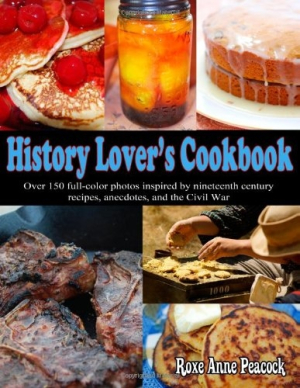History Lover's Cookbook
Over 150 full-color photos inspired by nineteenth century recipes, anecdotes, and the Civil War
Armies march on their stomachs, and here’s how Civil War-era cooks prepared the food.
History Lover’s Cookbook, by Roxe Anne Peacock, reflects the author’s passion for history and cooking. The book offers a breezy overview of Civil War history and is a good resource for adventurous cooks who want to learn more about period cooking techniques and foods. It is organized chronologically, from the fall of Fort Sumter in 1861 to General Robert E. Lee’s surrender at Appomattox in 1865. Peacock summarizes military and political actions, punctuated by interesting anecdotes about historical characters, paragraphs about food and social history, and recipes to make at home or at the campfire, inspired by nineteenth-century cooks.
The book features a wealth of color photographs throughout. The majority of these images are crisply reproduced and impart wonderful atmospheric detail. However, some are grainy and pixelated, and many of the food photographs are shot with flat lighting and/or are way too close up. It is a food photography challenge to depict a pot of tomato ketchup or corn pudding with skill, but the better editorial choice might be to leave out photographs of the less visually appealing dishes.
There’s an endearing personal flavor throughout this volume, which was designed by the author’s daughter and features many stories about the early military career of George Armstrong Custer, since the author’s husband portrays him in a historical troupe. Peacock’s family has long been involved in Civil War reenactment, a tradition that extends now to the grandchildren. The author also does an excellent job of pointing out how cooking techniques, medical care, and social mores differ from the Civil War era to the present day.
Though Peacock is an enthusiastic writer, the book would benefit from tighter copyediting. There are numerous misspellings, grammatical mistakes, and unclear sentences. Some paragraphs need more factual detail, as on page 113 when there’s a discussion of bread riots somewhere in the Confederacy, and on the second page’s short paragraph about Confederate sympathizer Rose O’Neal Greenhow, which ends with the phrase, “Rose became the first female spy to be discovered.” Discovered by whom and when?
There are also some strange segues in the text, as when Peacock mentions in the overview that the only civilian to die at the Battle of Gettysburg was killed while baking bread for Union soldiers. The next sentence reads, “Give a gift of fresh baked bread with a jar of homemade lemon butter.”
The layout alternates between looking cramped and vacant. The paragraphs primarily consist of one or two sentences with no spacing to separate them, and this makes for choppy reading. Other pages have abundant areas of blank space. A format that uses appropriate spacing and additional photos, menus, or tidbits of information that follow many of the recipes to create visual interest would be more balanced and easier to read.
Even with the flaws, History Lover’s Cookbook could appeal to a variety of readers interested in American military and social history and in historical cookbooks. It is an inviting way to introduce Civil War and nineteenth-century social history to young adults and is an excellent resource for educators looking for project ideas to help reinforce historical facts and themes.
Reviewed by
Rachel Jagareski
Disclosure: This article is not an endorsement, but a review. The publisher of this book provided free copies of the book and paid a small fee to have their book reviewed by a professional reviewer. Foreword Reviews and Clarion Reviews make no guarantee that the publisher will receive a positive review. Foreword Magazine, Inc. is disclosing this in accordance with the Federal Trade Commission’s 16 CFR, Part 255.

